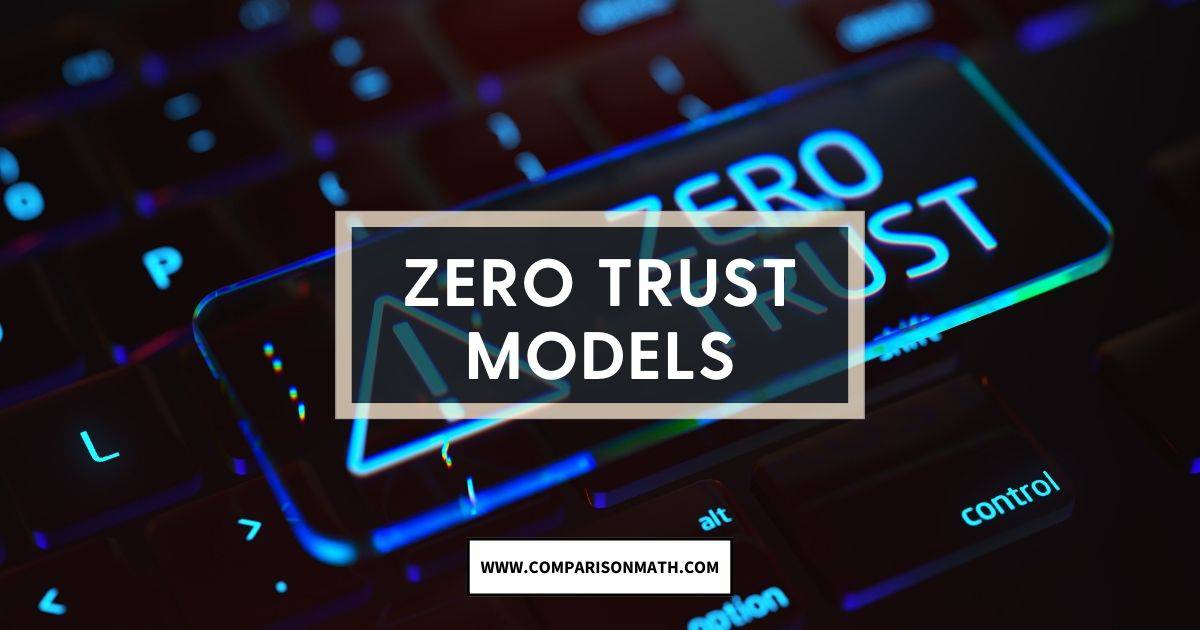Physical Address
304 North Cardinal St.
Dorchester Center, MA 02124

In today’s fast-paced digital world, where cyber threats evolve as rapidly as the technologies designed to combat them, a robust and adaptive security strategy is not just a necessity; it’s a critical lifeline for any organization. Enter the concept of Zero Trust Models – a paradigm shift in cybersecurity that challenges traditional security models and offers a more dynamic approach to protecting valuable digital assets.

As we delve into the intricate world of Zero Trust Models, we’ll explore why this methodology is becoming the cornerstone of modern cybersecurity strategies. From understanding its fundamentals to implementing it in your organization, and from overcoming challenges to peeking into its future, this comprehensive guide aims to equip you with all the knowledge you need to make informed decisions about adopting Zero Trust Models.
Cybersecurity, like any other field, has its history, marked by an ongoing battle between security measures and emerging threats. Zero Trust Models didn’t just appear out of thin air; they are the result of decades of evolving cybersecurity practices.
A Brief History of Cybersecurity
In the early days of the internet, perimeter-based security was the norm. This approach, akin to building a fortress, focused on securing the boundaries of networks. However, as technology evolved, so did the complexity and sophistication of cyber threats. The realization dawned that not all threats come from outside; sometimes, the enemy is already inside the gates.
‘Never Trust, Always Verify’
This is the foundational principle of Zero Trust Models. Unlike traditional models that operate on implicit trust once inside the network, Zero Trust assumes that trust is a vulnerability. It operates on the assumption that threats can exist both outside and within an organization’s network.
A successful zero-trust strategy hinges on several critical components:
The key difference lies in the approach to trust. Traditional models operate on the premise of ‘trust but verify,’ granting users full access once they’re inside the network. Zero Trust Models, on the other hand, operate on a ‘never trust, always verify’ basis, constantly validating every attempt to access the system, regardless of the user’s location.
Transitioning to a Zero Trust Model is not a one-size-fits-all process; it requires careful planning and consideration.
Before implementing Zero Trust, it’s crucial to understand where your organization currently stands in terms of security. This involves:
Creating a Zero Trust strategy involves:
Key practices include:
While the benefits of Zero Trust Models are substantial, there are also challenges to be considered.
Zero Trust Models significantly bolster security. For instance, a company that implemented Zero Trust saw a 60% reduction in security breaches within the first year. These models are especially effective in mitigating internal threats, one of the most challenging aspects of cybersecurity.
While Zero Trust enhances security, it can also impact operations and user experience. For example, the additional authentication steps might initially seem cumbersome to employees. Balancing security with user convenience is crucial.
Challenges such as legacy systems compatibility and initial resistance from employees are common. Addressing these challenges involves strategic planning and ensuring buy-in from all stakeholders.
As we look ahead, Zero Trust Models are set to become even more integral to cybersecurity strategies.
The integration of AI and machine learning in Zero Trust frameworks is one of the most exciting developments in this area. These technologies enable more sophisticated threat detection and response mechanisms, making Zero Trust Models more dynamic and adaptable.
AI in Enhancing Zero Trust:
AI can analyze patterns and detect anomalies in network behaviour, flagging potential threats more efficiently than traditional methods. For instance, an AI system might identify a seemingly normal login as suspicious based on the login time or the location from which it originates, thereby adding another layer of security.
As we move forward, Zero Trust Models are expected to become more prevalent, particularly in sectors like finance, healthcare, and government, where data security is paramount. Experts predict that by 2025, over 80% of new digital business applications will adopt Zero Trust network access.
Remember, transitioning to a Zero Trust Model is a journey, not a destination. Regularly review and adapt your strategies to ensure your organization remains resilient against evolving cyber threats.
Zero Trust Models represent a significant shift in how we approach cybersecurity. By adopting a stance of ‘never trust, always verify,’ organizations can significantly bolster their defences against external and internal threats. As we’ve seen, implementing Zero Trust requires a comprehensive strategy, but the benefits it brings in terms of enhanced security and reduced risk of breaches are invaluable.
In conclusion, Zero Trust Models are not just a trend; they are the future of cybersecurity. As threats continue to evolve, so must our approaches to protecting our most valuable digital assets. Zero Trust offers a proactive, dynamic, and effective method to do just that.
We encourage you to assess your organization’s current security posture and consider how Zero Trust Models can enhance your cybersecurity strategy. Remember, in the world of cybersecurity, it’s not just about building higher walls; it’s about making smarter, more informed decisions about who and what to trust.
Comments Section
We would love to hear your thoughts and experiences regarding Zero Trust Models. Have you implemented Zero Trust in your organization? What challenges did you face, and how did you overcome them? Share your stories in the comments below!
Zero Trust is a security concept centred on the belief that organizations should not automatically trust anything inside or outside its perimeters and instead must verify anything and everything trying to connect to its systems before granting access.
By verifying every user and device, whether inside or outside the organization’s network, Zero Trust minimizes the attack surface and reduces the chance of unauthorized access.
The cost of implementing Zero Trust varies depending on the size and complexity of an organization’s network. However, the long-term benefits, including reduced risk of data breaches, often outweigh the initial investment.
Zero Trust is a critical concept in modern cybersecurity for several reasons:
Evolving Cyber Threats: In an era where cyber threats are becoming more sophisticated, traditional security measures are no longer adequate. Zero Trust provides a more robust framework that assumes breaches can happen at any point, thus offering continuous protection.
Protecting Sensitive Data: As organizations handle increasing amounts of sensitive data, protecting this data from both external and internal threats becomes paramount. Zero Trust helps ensure that only authorized users can access specific data, significantly reducing the risk of data breaches.
Adapting to Modern Work Environments: With the rise of remote work, BYOD (Bring Your Device) policies, and cloud computing, the traditional security perimeter has dissolved. Zero Trust accommodates these changes by focusing on securing resources regardless of location.
Regulatory Compliance: Many industries face stringent regulatory requirements for data security. Implementing Zero Trust can help organizations meet these requirements by demonstrating a proactive approach to data protection.
Enhancing User Experience: While ensuring security, Zero Trust can also streamline user experience by providing users with seamless yet secure access to necessary resources.
Zero Trust works on the principle of “never trust, always verify”. Here’s how it operates:
Strict Identity Verification: Every time a user or device attempts to access resources, their identity is rigorously verified, often using multi-factor authentication (MFA). This is true even for users inside the organization’s network.
Least Privilege Access: Users are granted the minimum level of access needed to perform their job functions. This limits the potential damage in case of a security breach, as attackers can’t easily access critical systems or data.
Micro-segmentation: The network is segmented into smaller zones, each with its security controls. This prevents lateral movement of attackers within the network, as they would need separate authorization to access different segments.
Continuous Monitoring and Adaptation: Zero Trust systems continuously monitor network traffic and user behaviour, looking for anomalies that might indicate a security threat. The system adapts its defences based on observed threats, making it a dynamic security solution.
Security Across All Layers: Zero Trust isn’t just about network security; it extends to data, assets, applications, and services, ensuring comprehensive protection across all organizational resources.
Implementing Zero Trust is a significant shift from traditional security models, requiring a combination of technology, policies, and a culture change, but it’s a necessary step toward robust cybersecurity in the digital age.